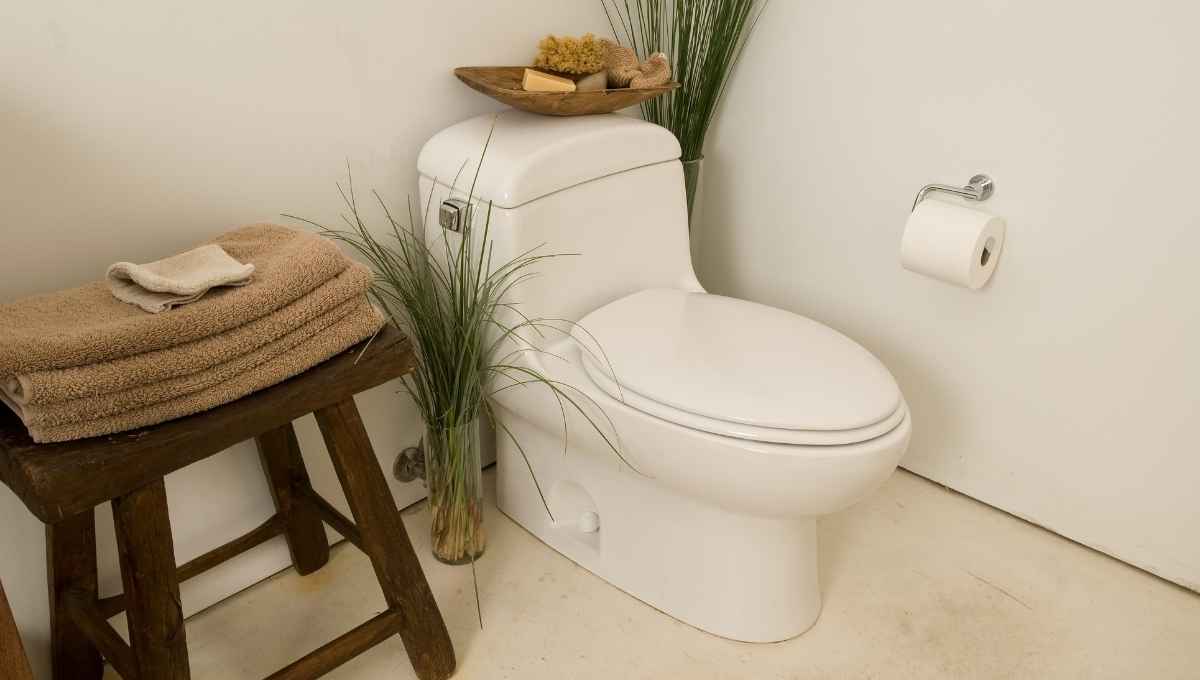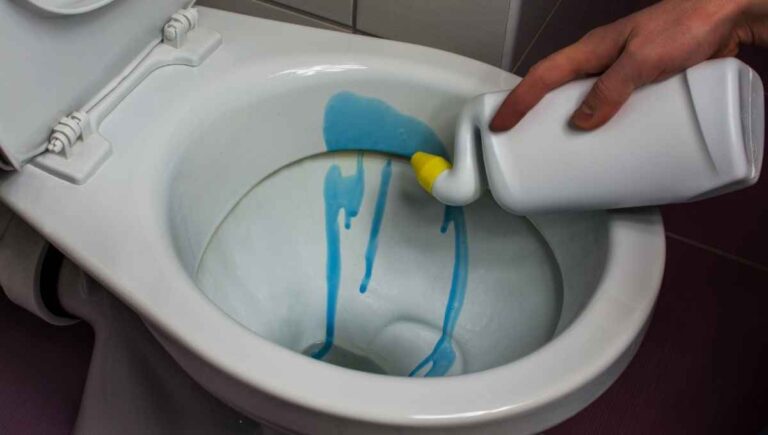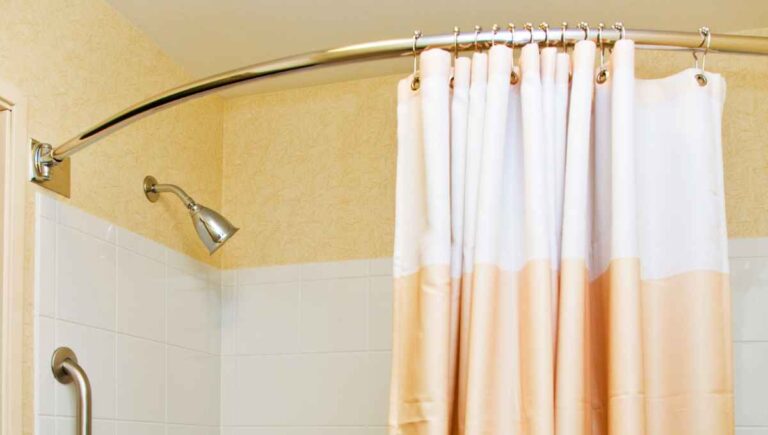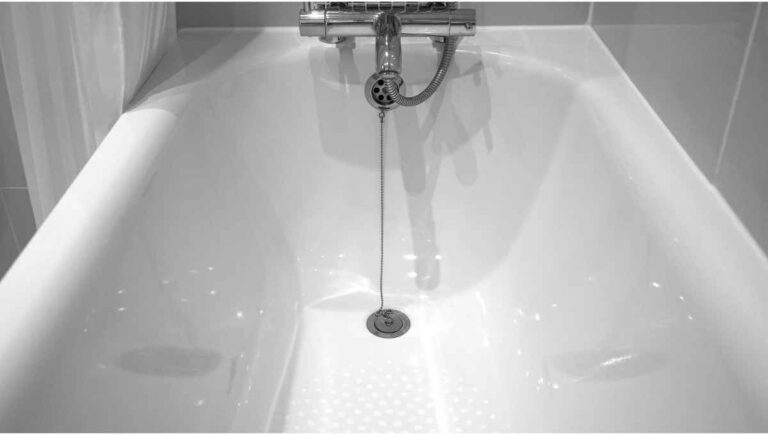Can a Toilet Fall Through the Floor? (5 Signs to Watch For)

Having your toilet fall through the floor is certainly not an ideal situation. But, if your bathroom floor has seen better days, this thought may have crossed your mind. However, it seems very unlikely. So, can a toilet really fall through the floor?
If your flooring is weak or damaged, it is possible for a toilet to fall through your flooring. If you notice your bathroom floor softening, or if you know there was a leak, be sure to check that your flooring and sub-flooring are solid.
There are a lot of signs that your flooring is not going to continue supporting the weight of your toilet. So we’ve gathered some common questions and answers concerning how to keep you and your home safe from falling toilets.
This post contains affiliate links. This means Household Blogger may earn a commission should you make a purchase using any of our links. Please refer to our full affiliate disclosure policy for full details.
Here’s a Quick Pro Tip!
Unfortunately, it is possible for your toilet to fall through the floor, especially if your floors are in rough shape!
To help you fix up those floors, we’ve gathered the most important tools you’ll need:
1. Electric Saw – This saw will easily cut through your damaged wood, allowing you to replace it with ease.
2. Plywood – Having the right wood to fix your flooring is essential. This high-quality plywood is designed for DIY work!
3. Electric Screwdriver – Save time and your hands with this easy-to-use screwdriver.
Signs of Damages
If you’re concerned your toilet may fall through the floor, you’ve probably noticed some changes to your bathroom. If you’ve noticed your floor is sagging or soft, you may have more significant issues going on below.
Can a Toilet Fall Through the Ceiling?
Given the right circumstances, toilets can succumb to gravity and fall through the ceiling. However, builders have strict standards for constructing bathrooms, making this issue very unlikely.
If you notice a leak, or a water stain, on your ceiling, it’s wise to have it checked out.
Stopping a leak while it’s small can prevent you from having to rip out and replace the whole floor later on.
Plus, if you stop it before it starts, you don’t have to worry about your toilet falling through the ceiling!
How Do You Know if Your Bathroom Floor Is Rotting?
There are many ways to tell if your bathroom floor is rotting. The most common signs include foul odors, mildew, and wet or sagging floors. These signs may mean it’s time to have someone come take a look at what’s going on beneath the surface!
If you think your bathroom floor is rotting, be on the lookout for a few big red flags:
- Mold – If you notice mold or mildew that regrows in the same spots, you may have water damage.
- Odors – A mildew or sewer smell can signify that there is water damage and that your floor may be rotting underneath you.
- Warping – If you notice that your walls or floor have warped, or if there is now cracking in your molding or grout that was not there initially, there may be a problem beneath the surface.
- Softening – Rotting wood is softer to the touch than wood that hasn’t undergone water damage. So if you notice that your bathroom flooring is softening, get it checked out!
- Staining – If you can see discoloration on the ceiling or floor, it may be a sign of water damage, causing your floors to rot.
You might also enjoy our post on How to Fix a Cracked Toilet Seat
How Is a Toilet Secured to the Floor?
There is a large circular piece, called a toilet flange, that connects your toilet to the floor and a drain pipe. This secures your toilet in place, utilizing bolts to keep it secure. Unfortunately, this flange loosening is a significant cause of toilet leaks.
Due to the nature of toilets, repeated use may cause the bolts holding the flange to the floor to loosen over time.
This may sound like a disaster, but it is pretty easy to retighten them. If that doesn’t work, you may need to replace the flange.
How Do I Know if My Toilet Is Leaking From Underneath?
You can tell your toilet is leaking by paying close attention to the flooring underneath it. For example, if you notice that your flooring is going soft, or if there’s mold festering around the sides of the toilet, you may have a leak problem.
Additionally, if you find there is excess water on your bathroom floor, or if you notice an increase in musty or moldy smells, it may be a sign of a more significant issue.
Leaking toilets are a major cause of other bathroom issues and can potentially lead to your toilet falling through the floor.
How Can You Tell if Your Bathroom Has Water Damage?
You can tell if your bathroom has water damage by paying attention to the walls and floors. If you notice any buckling or warping to your walls or the floor, water damage is likely happening beneath the surface.
You also want to keep an eye out for visible mold or mildew. This is another big sign pointing to water damage.
Also, even before you can see mold or mildew, you may be able to smell it, so if your nose says something is off, check for water leaks!
How Can You Tell if a Ceiling Is Going to Collapse?
If you know there is water damage in your bathroom and you’re worried the ceiling will collapse, keep an eye out for buckling or cracking. There may also be signs of water damage, such as wet spots or discoloration.
Additionally, if you ever see your ceiling buckling and then hear a loud cracking noise, be sure to move out of that space, as odds are something broke, and it is very possible your ceiling will cave in.
If you’re worried that is a possibility, stay outside of that room and call someone for repairs, if necessary.
What Are the Signs of Floor Damage Around a Toilet?
The most common sign of floor damage around a toilet is a soft floor and warped walls. In addition, if your toilet has been slowly leaking, you may notice an increase in your water bill or see that the toilet has been running more often.
Another sign of floor damage around a toilet is mold and mildew growth. This may come as visible mold or even just a musty odor.
Lastly, if you notice your toilet has gotten loose or wobbles when used. This may mean you’ve got a major leak!
You might also enjoy our post on If Toilet Seat Covers Can be Flushed
Can a Leak Cause the Ceiling to Collapse?
If your upstairs bathroom has a leak, a ceiling collapse is a big concern. It is possible, though unlikely, for a leak to cause your ceiling to collapse. If you notice any water or discoloration on your ceiling, be sure to investigate.
Allowing a minor leak to continue on from your toilet may seem like no big deal, something you can put off fixing for a little while, but it can cause a big headache in no time.
Even small leaks can lead to your floors rotting and your ceiling eventually caving in.
Water-Related Issues
Now that we’ve discussed some common damages from leaking toilets let’s get into the how’s and why’s of a leak and water-related issues, and how to fix them!
Why Is the Floor Around My Toilet Wet?
If you’re experiencing wet floors around your toilet with no discernible cause, you may have a leak in the base of your toilet. A loose flange may cause this leak. If you notice your toilet is wobbly, try tightening the flange.
If you are noticing that your floor is consistently wet, you need to figure out the root cause. Not dealing with a small leak can lead to enormous consequences!
These consequences can include floor rot and, in extreme circumstances, your toilet falling through the floor.
Why Is My Bathroom Floor Buckling?
If you notice your bathroom floor softening or buckling, the wood underneath may start to rot. This is typically caused by water damage. Consider checking your pipes for leaks.
Buckling and sagging occurring in your bathroom are often a sign of trouble. Ignoring those signs can lead to more significant problems down the line.
If you notice a leak, be sure to get it fixed ASAP to avoid future messes.
Why Is the Floor Around My Toilet Soft?
The floor around your toilet may be soft because water is leaking from your pipes or toilet. These leaks can cause water damage. Water damage can lead to your floors rotting or buckling.
Soft floors are no laughing matter. As soon as a weak spot on your floor comes to your attention, be sure to have it checked for water damage.
Ignoring water damage or soft spots can lead to your floors rotting and can cause significant damage to your bathroom.
Why Is My Bathroom Floor Squishy?
Your bathroom floor may seem squishy because the wood underneath your tile is soft. Soft flooring is a sign of water damage to the wood underneath your flooring. This will need to be replaced to avoid a major catastrophe.
Ignoring a squishy spot on your bathroom floor can lead to significant damages, meaning you’ll be spending major $$$’s to get it fixed.
So if you notice a squishy spot, be sure to get it checked as soon as possible! While you’re at it, make sure you check for leaky pipes too!
Why Is My Floor Sagging Under My Toilet?
A saggy floor under your toilet may mean you’ve got a leak somewhere in your plumbing. Typically, sagging means rotting wood. Rotting wood can cause significant issues, up to and including eventual floor collapse.
If you’re concerned about floor collapse, you can check on the wood surrounding your toilet and, if necessary, get a flange floor support.
These supports can help your flooring withstand the weight of a toilet.
Why Is My Toilet Loose From the Floor?
A loose toilet is most typically caused by a loose flange. A flange is the piece of your toilet that connects the base to the floor. When these come loose, you may notice a bit of water leaking from your toilet and a pronounced wobble when you use your toilet.
Luckily, a loose flange is an easy fix!
You should be able to tighten the flange yourself. Simply find the screws located at the base of your toilet and use a screwdriver or nut wrench to tighten up the screws.
Why Is My Upstairs Bathroom Leaking Through the Ceiling?
Finding a leak coming through the ceiling from your upstairs bathroom is a situation no one wants to deal with. But, unfortunately, sometimes leaks happen. So first, check to ensure your toilet is not loose.
If the leak isn’t coming directly from a loose toilet, you may have a blocked or otherwise broken pipe.
Other important things to check are O-rings, gaskets, or washers in your pipes. If any of these pieces crack, it may cause water issues.
Why Is Water Coming up Through the Floor?
Finding water coming up through your floors is a concerning sight. If you see water coming through your bathroom floor, and you haven’t even showered yet, you probably have a leak somewhere.
This may be due to a loose toilet or because of a crack in or around the base of your shower. Also, check under your sink for any damp patches.
Once you’ve narrowed down where the leak is coming from, you can fix it!
Best Fixes
Now that you know the common causes of bathroom leaks and the signs to see them, we will discuss the most important part, how to fix it!
Stick with us for the best tips and tricks to get your bathroom back in shape!
What to Do if Your Toilet Is Leaking Through the Ceiling
If you know your toilet has a leak, and that leak has now permeated through the floor onto the ceiling of a lower level, you know you have a problem. You can try tightening the flange of your toilet (near the floor.)
If tightening the flange doesn’t fix your issue, you may have a problem with an O-ring or other gasket.
You will have to turn off your water, drain out any water remaining in the toilet, and disconnect the bowl to check for broken gaskets in the plumbing.
Once you know the issue, replacing the gasket is relatively easy. Get yourself some new gaskets before you start! Then, simply remove the old gasket, replace it with a new one, reconnect your toilet bowl, and turn your water back on.
How Do You Fix a Toilet That Is Sinking Into the Floor?
If you’re having issues with a sinking toilet, you’re probably worried that the toilet may fall through the floor. If you need to fix a toilet that is sinking into the floor, start with removing the flooring around the toilet.
Before starting this repair, make sure the water line has been turned off. If you find that the wood surrounding the base of the toilet is soft or even rotten, it’s going to need to be replaced.
You can remove the rotted wood with a crowbar or claw hammer.
You will then need to measure and cut plywood to fit into the torn-out area. Use heavy-duty wood screws to ensure the plywood will not come loose.
Once the bracing is in place, you will simply need to recover the plywood with your flooring of choice and reattach your toilet.
How Do You Fix a Leaning Toilet?
If your toilet is leaning or wobbly, check first for any leaking pipes. Ignoring a leak can lead to water damage to your flooring. Wet flooring can lead to rotting pipes and a potential collapse of your bathroom floor. Next, try tightening the flange.
A toilet’s flange is the piece that connects the main base of the toilet to the floor and the interior sewer piping.
You can tighten the flange with a screwdriver or nut wrench, depending on the style of your toilet. This should fix the lean with little hassle.
How Do You Level a Toilet on an Uneven Floor?
If you’re struggling to level a toilet on an uneven floor, you will need to brace the short side of your unlevel flooring to prevent your toilet from leaning or wobbling. The easiest way to do this is with a shim.
A toilet shim can be placed under one side of a toilet flange to help level the toilet without an expensive and time-consuming job.
This will stabilize your toilet and can prevent you from having to replace your flooring in the future.
How Do You Fix a Soft Bathroom Floor?
Unfortunately, if your bathroom floor is soft and rotting from a leaky pipe, the best fix is to replace the rotting spot. If you ignore a soft spot, the problem will just keep growing under the surface, and you’ll risk your floor collapsing in the future.
Hopefully, if you caught the soft spot early, you won’t have to mess with the sub-flooring underneath.
To get rid of the rot, you’ll have to cut out the damaged wood and replace it with new boards.
Can You Replace Bathroom Floor Without Removing Toilet?
While it may be technically possible to replace the flooring in your bathroom without removing the toilet, going this route will cause your job to actually take longer. Having to work around the toilet will take up considerably more time than simply removing the toilet from the base.
Another great reason to remove your toilet before starting a flooring renovation is that having the toilet removed allows you property reset the toilet on the new flooring.
This ensures the toilet stays level and is not wobbly, preventing leaks.
Going Deeper
Sometimes, leaks under the surface go undiscovered until there is a major problem. If you’re looking at rotting subflooring, you’ve got a job in front of you. We’ve gathered some of the top solutions to sub-flooring problems.
How Do You Fix a Subfloor?
If your subflooring was damaged by water, you need to make sure you’ve fixed any leaks before diving into fixing the subfloor. If you’re sure the leaks are fixed, you can fix the subfloor by replacing any rotten wood in the subfloor.
Fixing the subflooring is very similar to replacing the base-level flooring. You’ll have to expose the subfloor, cut out the damaged wood, then replace it with new subflooring.
One important note, make sure your remaining subflooring is completely dry before putting in the new section.
Does Subfloor Go Under Toilet Flange?
Your toilet flange belongs on top of any finished floors, well above the subfloor. Having the flange under the subfloor would cause lots of hassles if it starts leaking or has other issues.
Additionally, having the flange below the subfloor would mean the toilet is going to sit very close to the ground, which would be an uncomfortable experience!
Remember, the seals of your flange are not designed to support extra space between floors.
How Much Does It Cost to Replace Bathroom Subfloor?
It can cost between $500-$600 to replace a bathroom subfloor, depending on materials, square footage, and labor, if you’re not doing the repair yourself. This price can vary depending on your area, so be sure to check around before hiring someone!
If you decide to do the fix yourself, you’ll need some good materials. Start with heavy-duty plywood, and make sure you have a good screwdriver and wood screws.
You will also need a saw and safety goggles.
What Can You Do if There Isn’t a Subfloor Under Toilet Flange?
If there isn’t a subfloor under your toilet flange, don’t stress. You don’t want to install your toilet flange on the subfloor level anyway. For best results, your flange should be placed on the same level as the toilet bowl.
Keeping your flange on the same level as the bowl means there is less likelihood of leaks and other issues stemming from stress on the flange.
It also means easier reach in case of emergencies, such as leaks.
Related Questions
Can a Bathtub Fall Through the Floor?
While it’s very unlikely for your bathtub to fall through the floor, in extreme circumstances, it is possible. If your flooring has been damaged by water and is rotting away, the support structures may fail, causing the bathtub to become unsecured.
If your bathtub isn’t secure, it is possible for it to fall.
If you’re concerned your flooring may be rotten, or if you have discovered a significant leak under your tub, be sure to have the flooring replaced before anything scary happens!
Final Thoughts
While the idea of your toilet falling through the floor, as long as you’re not ignoring the warning signs, you probably don’t have to worry.
If you notice soft spots or mold, get it taken care of right away, and you can stop worrying about an unexpected cave-in. Enjoy your new peace of mind!














